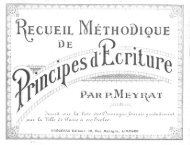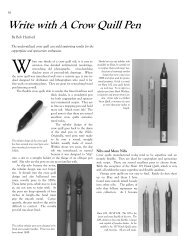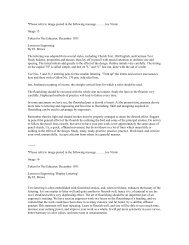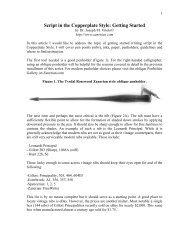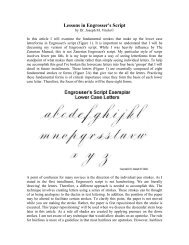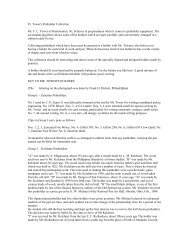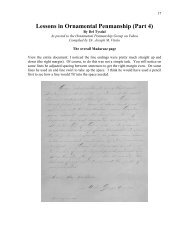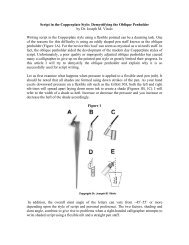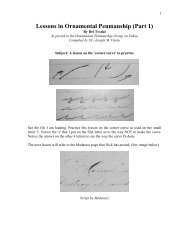The Educator (Volume 45) - IAMPETH
The Educator (Volume 45) - IAMPETH
The Educator (Volume 45) - IAMPETH
You also want an ePaper? Increase the reach of your titles
YUMPU automatically turns print PDFs into web optimized ePapers that Google loves.
meaning at first glance; a man a<br />
woman are easily distinguished; so<br />
is a child when it becomes evident<br />
that the figure is engaged in sucking<br />
its thumb.<br />
Gradually from the hieroglyphics<br />
there was evolved the hieratic, the<br />
abbreviated form of the former. It<br />
was employed by the priest from the<br />
fourth to the sixth dynasty. This<br />
writing is found in the earliest Egyptian<br />
books preserved. This hieratic<br />
writing shows but faint traces of its<br />
original pictorial character and even<br />
these were lost in the demotic form<br />
which began by conventional signs.<br />
This demotic form developed between<br />
the third and fourth centuries B. C.<br />
into Egypt, the use of the old writing<br />
forms declined. No inscriptions<br />
are to be found in any of the three<br />
styles after the middle of the fifth<br />
century B. C.<br />
An interesting fact about hieroglyphics<br />
concerns the direction of<br />
the writing. This was not, as in<br />
most writing, fixed, but depended on<br />
the whim of the writer or the shape<br />
of the material to be inscribed. Sometimes<br />
they were to be read from<br />
right to left, less commonly from<br />
left to right; while frequently they<br />
were to be read vertically downwards.<br />
Through the Middle Ages and well<br />
into modern times, no interest was<br />
felt in these old hieroglyphics, but<br />
from the seventeenth century, scholars<br />
made occasional efforts to decipher<br />
the inscriptions. <strong>The</strong> problem<br />
seemed insoluble, however, until the<br />
discovery of the Rosetta Stone threw<br />
light upon it.<br />
<strong>The</strong> cuneiform inscriptions and<br />
also the writing of the Chinese developed<br />
from an original pictorial<br />
form. In some of the letters, which<br />
make up the alphabets of European<br />
peoples, the primitive ideograms may<br />
be traced.<br />
Writing in which symbols represent<br />
sounds is called phonetic. <strong>The</strong><br />
Phoenicians invented the first phonetic<br />
alphabet. All the alphabets of<br />
the modern times are derived from<br />
this first alphabet.<br />
<strong>The</strong> name alphabet is derived from<br />
the names of the letters, alpha and<br />
beta, and denotes a set of characters,<br />
or, as we call them letters, each of<br />
which represents a given sound.<br />
Syllabraries and alphabets are the<br />
conventionalized stages of writing.<br />
All the alphabets of modern Europe<br />
may be traced back to the Greek<br />
alphabet, which was in its turn derived<br />
from the Phoenician. Just<br />
when it was introduced is not known,<br />
but there are inscriptions which date<br />
from the seventh century B. C. Originally<br />
the Greek wi-iting, like the<br />
Phoenician, was from left to right,<br />
later the direction was alternated,<br />
but from 500 B. C. a uniform direction<br />
from left to right was followed.<br />
<strong>The</strong> original Latin alphabet, as it<br />
is found in the oldest inscriptions,<br />
consisted of twenty-one letters;<br />
<strong>The</strong> <strong>Educator</strong> 15<br />
namely, the vowels a. e, i, o, u, and<br />
the consonants b, c, d, f, z, h, k, 1,<br />
m, n, p, q, r, s, t, x. Z slipped out<br />
at an early period and g took its<br />
place. No genuine Latin word contains<br />
either y or z, these being used<br />
in foreign (chiefly Greek) words<br />
adopted into the language; and k is<br />
found in classical Latin only in Kalendae.<br />
Our modern lower-case letters<br />
and script represent adaptations<br />
of the Garolingian minuscule of the<br />
ninth century, which itself descended<br />
from the uncials or bookhands of<br />
still earlier periods. <strong>The</strong> most important<br />
of these were the Roman<br />
uncials, which are essentially made<br />
up of rounded capital form.<br />
About the time of Cicero, the characters<br />
y, u. and z were introduced at<br />
the end of the alphabet. This Latin<br />
alphabet, as spread by the Roman<br />
conquests became the alphabet of<br />
most of the modern European languages.<br />
<strong>The</strong> Latin or Roman alphabet<br />
which came into use in Italy about<br />
the sixth or fifth century B. C. became<br />
the medium for the classical<br />
literature of Rome. <strong>The</strong> oldest Roman<br />
inscriptions show the original<br />
Greek letters in simplified form.<br />
Some of the Greek letters are entirely<br />
omitted. <strong>The</strong> five additional<br />
letters of our English alphabet arose<br />
from the introduction of z, the differentiation<br />
of i and j, and the expansion<br />
of w into u, w, and y. <strong>The</strong><br />
German alphabet also comes from<br />
the Latin, but the letters contain the<br />
queer Gothic shapes of the Middle<br />
Ages.<br />
<strong>The</strong> oldest extant records of the<br />
Latin alphabet are first, the inscription<br />
known as the "Duenos Inscription"<br />
(it read DVENOS MED<br />
FECED) found in 1880 in Rome<br />
upon an earthenware vessel with<br />
three separate branches, dating from<br />
the former half of the fourth century<br />
B. C; second is the Praeneste<br />
fibula, dating from the sixth or fifth<br />
century B. C, the inscription of<br />
which runs from right to left. It<br />
reads MANIOS MED FHEFHAKED<br />
NUMASIOI, and is remarkable as illustrating<br />
the device of combining<br />
the letters F and H to represent the<br />
sound of F which was common in<br />
Latin. <strong>The</strong> third instance of early<br />
Latin is an inscription upon a column<br />
found in the Roman forum and<br />
dating probably from the fifth century<br />
B. C.<br />
When after the conquest of Greece,<br />
Greek words began to be borrowed by<br />
the Latin Language, the symbols Y<br />
and Z were adopted from the Greek<br />
language and placed at the end of<br />
the alphabet.<br />
<strong>The</strong> Latin alphabet of twenty-three<br />
letters (including y and z) became<br />
extended during the Middle Ages to<br />
our own of twenty-six by the division<br />
of i and j and the tripartite division<br />
of V into u, v, and w. J developed<br />
in the fifteenth century as an initial<br />
(more ornate) form of i, and as the<br />
consonantal sound occurred more<br />
usually at the beginning of words<br />
and the vocalic in the middle, j became<br />
specialized to represent the<br />
consonant, i the vowel. <strong>The</strong> history<br />
of us and v is precisely similar except<br />
that it took place five centuries<br />
earlier. W arose, as its name implies,<br />
out of a combination of uu or<br />
vv. In about the eleventh century it<br />
came to represent in old English the<br />
w sound which had previously been<br />
represented by a rune.<br />
<strong>The</strong> Latin characters are now employed<br />
by many nations, such as the<br />
Italian, the French, the Spanish, the<br />
Portuguese, the English, the Dutch,<br />
the German, the Hungarian, the<br />
Polish, etc., each having introduced<br />
such modifications or additions as are<br />
necessary to express the sound of the<br />
language peculiar to it.<br />
As trade and travel brings the na-<br />
tions into closer relations, there is a<br />
general tendency to adopt the Roman<br />
alphabet.<br />
<strong>The</strong> Japanese have began to use it<br />
for commercial purposes, although<br />
their literature is still written in<br />
Chinese characters. Even the Chinese<br />
have taken some steps to discard<br />
their old ideographic system and to<br />
develop alphabetic writing.<br />
DR. A. L. HOWARD RETIRES<br />
In February Dr. Howard, the su-<br />
pervisor of business practice classes<br />
of the District of Columbia public<br />
schools, retired. Dr. Howard has<br />
served the schools of Washington for<br />
almost half a century and has won<br />
the admiration and respect of students,<br />
teachers, and administrators.<br />
After graduating from the old<br />
Central High School, Dr. Howard attended<br />
the Washington Normal<br />
School. His early teaching was done<br />
at the Abbot School, now one of<br />
Washington's vocational schools.<br />
While he was teaching, he was<br />
awarded a doctor's degree by the<br />
Georgetown University Medical<br />
School. Soon afterwards he was promoted<br />
to the old Business High<br />
School and taught there until he was<br />
appointed supervisor over twenty<br />
years ago.<br />
It was with regret that the teach-<br />
ers and administrators learned of<br />
Dr. Howard's retirement, for through<br />
his retirement Washington lost one<br />
of her finest educators.<br />
—Submitted by Mary Ellen Meiring,<br />
Teacher, Langley Junior High<br />
School, Washington, D. C.



